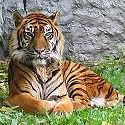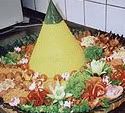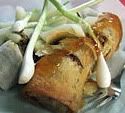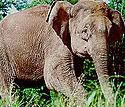
Pencak Silat
 Pencak Silat is a martial art from Indonesia. The art has also reached Europe, and is especially popular in the Netherlands, Spain and France. The head organisation of Pencak Silat is PERSILAT.
Pencak Silat is a martial art from Indonesia. The art has also reached Europe, and is especially popular in the Netherlands, Spain and France. The head organisation of Pencak Silat is PERSILAT.History
Each region in the archipelago has its own version of its origin which is largely based on oral tradition.
Silat takes important role in country's history. Since the age of Ancient Indonesian Hindu-Buddhist kingdoms like Srivijaya, Majapahit, Kingdom of Sunda . They used silat to train their soldiers and warriors.
According to tradition of Minangkabau, their Silek (Minangkabau pencak silat) can be traced to the fore father of ancient Minangkabau people, Datuk Suri Dirajo .
Also in ancient times, the Buginese and Makasar people from South Sulawesi region were known as tough sailors, adventurers, mercenaries and fearless warriors . Throughout the archipelago, these people were known for their combat skills. Nowadays, some well known silat schools in Malaysia can trace their lineage back to ancient buginese warriors.
Music
Every region in the archipelago has its own music for Silat performances. In West Java, for example, Sundanese people use gendang penca. In West Sumatra, Minangkabau people sometimes use a special instrument called Saluang.
Weapons
Along with the human body, Pencak Silat employs several weapons. Among the hundreds of styles are dozens of weapons, including:
- Kris/Keris: A curvy blade made from folding different types of metal together and then is washed in acid, giving the blade its distinct look.
- Kujang: Sundanese blade
- Badik Buginese and Makasarese blade
- Pedang/Sundang: A sword, either single or double edged.
- Parang/Golok: A machete/broadsword, commonly used in daily tasks, especially those involving farming or harvesting.
- Lembing/Seligi: A spear/javelin made of either wood or bamboo.
- Kayu/Batang: Stick, staff or rod made of bamboo, steel or wood.
- Chabang/Cabang: Three-pronged knife thought to derive from the trisula (trident)
- Karambit: A small claw-like curved blade or dagger worn in the hair. Easily concealed and is known as a woman's weapon.
- Sabit/Clurit: A sickle, commonly used in farming, cultivation and harvesting of crops.
- Tongkat/Toya: A walking stick carried by the elderly or travellers. (source)



















0 comments:
Post a Comment